Global Sensitivity Analysis of the Advanced ORYZA-N Model with Different Rice Types and Irrigation Regimes
Abstract
1. Introduction
2. Results and Discussion
2.1. Sensitivity Indices of Parameters for Model Crop-Related Outputs at Different Development Stages
2.1.1. Basic Vegetative Phase
2.1.2. Photoperiod-Sensitive Phase
2.1.3. Panicle-Formation Phase
2.1.4. Grain-Filling Phase
2.2. Sensitivity Indices of Parameters for Model Nitrogen-Related Outputs at Different Development Stages
2.2.1. Basic Vegetative Phase
2.2.2. Photoperiod-Sensitive Phase
2.2.3. Panicle-Formation Phase
2.2.4. Grain-Filling Phase
2.3. Sensitivity Indices of Parameters for Yield at Maturity
3. Materials and Methods
3.1. ORYZA-N Model
3.2. Extended FAST Method
3.3. Experiment and Data
3.4. Model Parameters and Sensitivity Analysis
4. Conclusions
Supplementary Materials
Author Contributions
Funding
Data Availability Statement
Conflicts of Interest
References
- FAO. FAOSTAT (Statistical Database of the Food and Agricultural Organization of the United Nations). Available online: http://faostat.fao.org/site/405/default.aspx (accessed on 5 February 2023).
- Ahmad, Z.U.; Sanin, M.; Lian, Q.Y.; Zappi, M.; Gang, D.D. Nonpoint Source Pollution. Water Environ. Res. 2017, 89, 1580–1602. [Google Scholar] [CrossRef]
- Guo, Y.; Chen, Y.; Searchinger, T.D.; Zhou, M.; Pan, D.; Yang, J.; Wu, L.; Cui, Z.; Zhang, W.; Zhang, F.; et al. Air quality, nitrogen use efficiency and food security in China are improved by cost-effective agricultural nitrogen management. Nat. Food 2020, 1, 648–658. [Google Scholar] [CrossRef] [PubMed]
- Li, Y.; Huang, G.; Chen, Z.; Xiong, Y.; Huang, Q.; Xu, X.; Huo, Z. Effects of irrigation and fertilization on grain yield, water and nitrogen dynamics and their use efficiency of spring wheat farmland in an arid agricultural watershed of Northwest China. Agric. Water Manag. 2022, 260, 107277. [Google Scholar] [CrossRef]
- Jin, X.; Li, Z.; Nie, C.; Xu, X.; Feng, H.; Guo, W.; Wang, J. Parameter sensitivity analysis of the AquaCrop model based on extended fourier amplitude sensitivity under different agro-meteorological conditions and application. Field Crops Res. 2018, 226, 1–15. [Google Scholar] [CrossRef]
- Ren, D.; Xu, X.; Engel, B.; Huang, G. Growth responses of crops and natural vegetation to irrigation and water table changes in an agro-ecosystem of Hetao, upper Yellow River basin: Scenario analysis on maize, sunflower, watermelon and tamarisk. Agric. Water Manag. 2018, 199, 93–104. [Google Scholar] [CrossRef]
- Gilardelli, C.; Confalonieri, R.; Cappelli, G.A.; Bellocchi, G. Sensitivity of WOFOST-based modelling solutions to crop parameters under climate change. Ecol. Model. 2018, 368, 1–14. [Google Scholar] [CrossRef]
- Tan, J.; Cui, Y.; Luo, Y. Global sensitivity analysis of outputs over rice-growth process in ORYZA model. Environ. Model. Softw. 2016, 83, 36–46. [Google Scholar] [CrossRef]
- Steduto, P.; Hsiao, T.C.; Raes, D.; Fereres, E. AquaCrop—The FAO Crop Model to Simulate Yield Response to Water: I. Concepts and Underlying Principles. Agron. J. 2009, 101, 426–437. [Google Scholar] [CrossRef]
- Confalonieri, R.; Bellocchi, G.; Bregaglio, S.; Donatelli, M.; Acutis, M. Comparison of sensitivity analysis techniques: A case study with the rice model WARM. Ecol. Model. 2010, 221, 1897–1906. [Google Scholar] [CrossRef]
- Gao, Y.; Xu, X.; Sun, C.; Ding, S.; Huo, Z.; Huang, G. Parameterization and modeling of paddy rice (Oryza sativa L. ssp. japonica) growth and water use in cold regions: Yield and water-saving analysis. Agric. Water Manag. 2021, 250, 106864. [Google Scholar] [CrossRef]
- Wang, J.; Li, X.; Lu, L.; Fang, F. Parameter sensitivity analysis of crop growth models based on the extended Fourier Amplitude Sensitivity Test method. Environ. Model. Softw. 2013, 48, 171–182. [Google Scholar] [CrossRef]
- Vazquez-Cruz, M.A.; Guzman-Cruz, R.; Lopez-Cruz, I.L.; Cornejo-Perez, O.; Torres-Pacheco, I.; Guevara-Gonzalez, R.G. Global sensitivity analysis by means of EFAST and Sobol’ methods and calibration of reduced state-variable TOMGRO model using genetic algorithms. Comput. Electron. Agric. 2014, 100, 1–12. [Google Scholar] [CrossRef]
- He, D.; Wang, E.; Wang, J.; Robertson, M.J. Data requirement for effective calibration of process-based crop models. Agric. For. Meteorol. 2017, 234–235, 136–148. [Google Scholar] [CrossRef]
- Liang, H.; Qi, Z.; DeJonge, K.C.; Hu, K.; Li, B. Global sensitivity and uncertainty analysis of nitrate leaching and crop yield simulation under different water and nitrogen management practices. Comput. Electron. Agric. 2017, 142, 201–210. [Google Scholar] [CrossRef]
- Saltelli, A.; Tarantola, S.; Campolongo, F.; Ratto, M. Sensitivity Analysis in Practice; Joint Research Centre of the European Commission: Ispra, Italy, 2004. [Google Scholar]
- Saltelli, A.; Tarantola, S.; Chan, K.P.S. A Quantitative Model-Independent Method for Global Sensitivity Analysis of Model Output. Technometrics 1999, 41, 39–56. [Google Scholar] [CrossRef]
- Ge, Q.; Menendez, M. Extending Morris method for qualitative global sensitivity analysis of models with dependent inputs. Reliab. Eng. Syst. Saf. 2017, 162, 28–39. [Google Scholar] [CrossRef]
- Kucherenko, S.; Klymenko, O.V.; Shah, N. Sobol’ indices for problems defined in non-rectangular domains. Reliab. Eng. Syst. Saf. 2017, 167, 218–231. [Google Scholar] [CrossRef]
- Morris, M.D. Factorial Sampling Plans for Preliminary Computational Experiments. Technometrics 1991, 33, 161–174. [Google Scholar] [CrossRef]
- Sobol, I.M. Sensitivity Estimates for Nonlinear Mathematical Models. Math. Model. Comput. Exp. 1993, 4, 407–414. [Google Scholar]
- Zhang, X.; Guo, H.; Wang, R.; Lin, D.; Gao, Y.; Lian, F.; Wang, J.A. Identification of the Most Sensitive Parameters of Winter Wheat on a Global Scale for Use in the EPIC Model. Agron. J. 2017, 109, 58–70. [Google Scholar] [CrossRef]
- Liu, J.; Liu, Z.; Zhu, A.-X.; Shen, F.; Lei, Q.; Duan, Z. Global sensitivity analysis of the APSIM-Oryza rice growth model under different environmental conditions. Sci. Total Environ. 2019, 651, 953–968. [Google Scholar] [CrossRef] [PubMed]
- DeJonge, K.C.; Ascough, J.C.; Ahmadi, M.; Andales, A.A.; Arabi, M. Global sensitivity and uncertainty analysis of a dynamic agroecosystem model under different irrigation treatments. Ecol. Model. 2012, 231, 113–125. [Google Scholar] [CrossRef]
- Soundharajan, B.; Sudheer, K.P. Sensitivity analysis and auto-calibration of ORYZA2000 using simulation-optimization framework. Paddy Water Environ. 2011, 11, 59–71. [Google Scholar] [CrossRef]
- Bouman, B.A.M.; Kropff, M.J.; Tuong, T.P.; Wopereis, M.C.S.; Ten Berge, H.F.M.; van Laar, H.H. ORYZA2000: Modeling Lowland Rice; International Rice Research Institute: Los Baños, Philippines; Wageningen University and Research Centre: Wageningen, The Netherlands, 2001. [Google Scholar]
- Bouman, B.A.M.; van Laar, H.H. Description and evaluation of the rice growth model ORYZA2000 under nitrogen-limited conditions. Agric. Syst. 2006, 87, 249–273. [Google Scholar] [CrossRef]
- Wang, X.; Li, T.; Yang, X.; Zhang, T.; Liu, Z.; Guo, E.; Liu, Z.; Qu, H.; Chen, X.; Wang, L.; et al. Rice yield potential, gaps and constraints during the past three decades in a climate-changing Northeast China. Agric. For. Meteorol. 2018, 259, 173–183. [Google Scholar] [CrossRef]
- Tan, J.; Cui, Y.; Luo, Y. Assessment of uncertainty and sensitivity analyses for ORYZA model under different ranges of parameter variation. Eur. J. Agron. 2017, 91, 54–62. [Google Scholar] [CrossRef]
- Gao, Y.; Sun, C.; Ramos, T.B.; Huo, Z.; Huang, G.; Xu, X. Modeling nitrogen dynamics and biomass production in rice paddy fields of cold regions with the ORYZA-N model. Ecol. Model. 2023, 475, 110184. [Google Scholar] [CrossRef]
- Yu, Q.; Cui, Y.; Liu, L. Assessment of the parameter sensitivity for the ORYZA model at the regional scale—A case study in the Yangtze River Basin. Environ. Model. Softw. 2023, 159, 105575. [Google Scholar] [CrossRef]
- Liang, H.; Xu, J.; Hou, H.; Qi, Z.; Yang, S.; Li, Y.; Hu, K. Modeling CH4 and N2O emissions for continuous and noncontinuous flooding rice systems. Agric. Syst. 2022, 203, 103528. [Google Scholar] [CrossRef]
- Rocha, A.V.; Appel, R.; Bret-Harte, M.S.; Euskirchen, E.S.; Salmon, V.; Shaver, G. Solar position confounds the relationship between ecosystem function and vegetation indices derived from solar and photosynthetically active radiation fluxes. Agric. For. Meteorol. 2021, 298–299, 108291. [Google Scholar] [CrossRef]
- Yan, Z.; Zhou, Q.; Teng, M.; Ji, H.; Zhang, J.; He, W.; Ye, Y.; Wang, B.; Wang, P. High planting density and leaf area index of masson pine forest reduce crown transmittance of photosynthetically active radiation. Glob. Ecol. Conserv. 2019, 20, e00759. [Google Scholar] [CrossRef]
- Zhu, X.; He, H.; Liu, M.; Yu, G.; Sun, X.; Gao, Y. Spatio-temporal variation of photosynthetically active radiation in China in recent 50 years. J. Geogr. Sci. 2010, 20, 803–817. [Google Scholar] [CrossRef]
- Tan, J.; Cui, Y.; Wang, W. Global sensitivity analysis for ORYZA(v3) model under different rice growing environments in China. Trans. Chin. Soc. Agric. Eng. 2020, 36, 153–163. [Google Scholar] [CrossRef]
- Huang, M.; Jiang, L.; Zou, Y.; Zhang, W. On-farm assessment of effect of low temperature at seedling stage on early-season rice quality. Field Crops Res. 2013, 141, 63–68. [Google Scholar] [CrossRef]
- Xu, L.; Zhan, X.; Yu, T.; Nie, L.; Huang, J.; Cui, K.; Wang, F.; Li, Y.; Peng, S. Yield performance of direct-seeded, double-season rice using varieties with short growth durations in central China. Field Crops Res. 2018, 227, 49–55. [Google Scholar] [CrossRef]
- Tu, D.; Wu, W.; Xi, M.; Zhou, Y.; Xu, Y.; Chen, J.; Shao, C.; Zhang, Y.; Zhao, Q. Effect of Temperature and Radiation on Indica Rice Yield and Quality in Middle Rice Cropping System. Plants 2022, 11, 2697. [Google Scholar] [CrossRef] [PubMed]
- Liu, L.; Ouyang, W.; Liu, H.; Zhu, J.; Ma, Y.; Wu, Q.; Chen, J.; Zhang, D. Potential of paddy drainage optimization to water and food security in China. Resoiurce Conserv. Recycl. 2021, 171, 105624. [Google Scholar] [CrossRef]
- Wang, Y.; Guo, F.; Shen, H.; Xing, X.; Ma, X. Global Sensitivity Analysis and Evaluation of the DSSAT Model for Summer Maize (Zea mays L.) Under Irrigation and Fertilizer Stress. Int. J. Plant Prod. 2021, 15, 523–539. [Google Scholar] [CrossRef]
- Hao, S.; Ryu, D.; Western, A.W.; Perry, E.; Bogena, H.; Franssen, H.J.H. Global sensitivity analysis of APSIM-wheat yield predictions to model parameters and inputs. Ecol. Model. 2024, 487, 110551. [Google Scholar] [CrossRef]
- Cui, Y.; Li, Y.; Lu, G.; Sha, Z. Nitrogen movement and transformation with different water supply for paddy rice. Adv. Water Sci. 2004, 15, 280–285. [Google Scholar]
- Sun, H.; Zhu, Y.; Yang, J.; Wang, X. Global sensitivity analysis for an integrated model for simulation of nitrogen dynamics under the irrigation with treated wastewater. Environ. Sci. Pollut. Res. 2015, 22, 16664–16675. [Google Scholar] [CrossRef]
- Simlab. SIMLAB: Sensitivity Analysis Software—Joint Research Centre of the European Commission. Available online: https://ec.europa.eu/jrc/en/samo/simlab (accessed on 10 April 2022).
- Amiri, E.; Rezaei, M.; Rezaei, E.E.; Bannayan, M. Evaluation of Ceres-Rice, Aquacrop and Oryza2000 Models in Simulation of Rice Yield Response to Different Irrigation and Nitrogen Management Strategies. J. Plant Nutr. 2014, 37, 1749–1769. [Google Scholar] [CrossRef]
- Zhang, J.; Feng, L.; Zou, H.; Liu, D.L. Using ORYZA2000 to model cold rice yield response to climate change in the Heilongjiang province, China. Crop J. 2015, 3, 317–327. [Google Scholar] [CrossRef]
- Saltelli, A.; Ratto, M.; Andres, T.; Campolongo, F.; Cariboni, J.; Gatelli, D.; Saisana, M.; Tarantola, S. Global Sensitivity Analysis: The Primer; John Wiley & Sons: Chichester, UK, 2008. [Google Scholar]
- Cukier, R.I.; Levine, H.B.; Shuler, K.E. Nonlinear sensitivity analysis of multiparameter model systems. J. Comput. Phys. 1978, 26, 1–42. [Google Scholar] [CrossRef]
- Sobol, I.M. On the Distribution of Points in a Cube and the Appeoximate Evaluation of Integral. USSR Comput. Math. Math. Phys. 1967, 7, 86–112. [Google Scholar] [CrossRef]
- Chen, E.J.; Chen, Y.-Y.; Wei, L.-C.; Luo, H.-B.; Gong, W. Uncertainty and Sensitivity Analysis of Significant Parameters for Superlarge Diameter Shield Excavation. Adv. Civ. Eng. 2021, 2021, 8819393. [Google Scholar] [CrossRef]
- Makowski, D.; Naud, C.; Jeuffroy, M.-H.; Barbottin, A.; Monod, H. Global sensitivity analysis for calculating the contribution of genetic parameters to the variance of crop model prediction. Reliab. Eng. Syst. Saf. 2006, 91, 1142–1147. [Google Scholar] [CrossRef]
- Allen, R.G.; Pereira, L.S.; Raes, D.; Smith, M. Crop Evapotranspiration—Guidelines for Computing Crop Water Requirements—FAO Irrigation and Drainage Paper 56; FAO: Rome, Italy, 1998. [Google Scholar]
- Tarantola, A. Inverse Problem Theory and Methods for Model Parameter Estimation; SIAM: Society for Industrial and Applied Mathematics: Philadelphia, PA, USA, 2005. [Google Scholar]

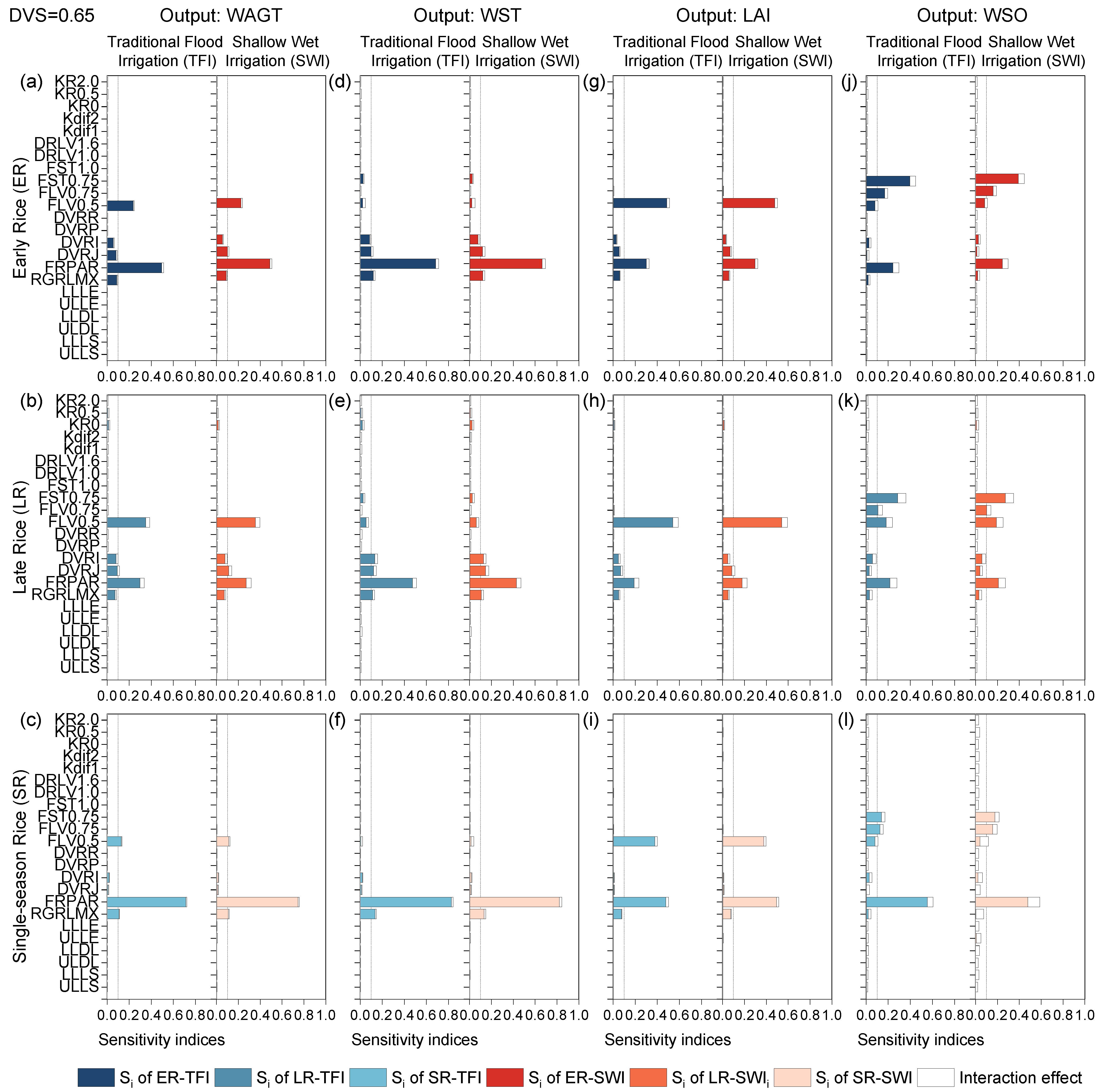

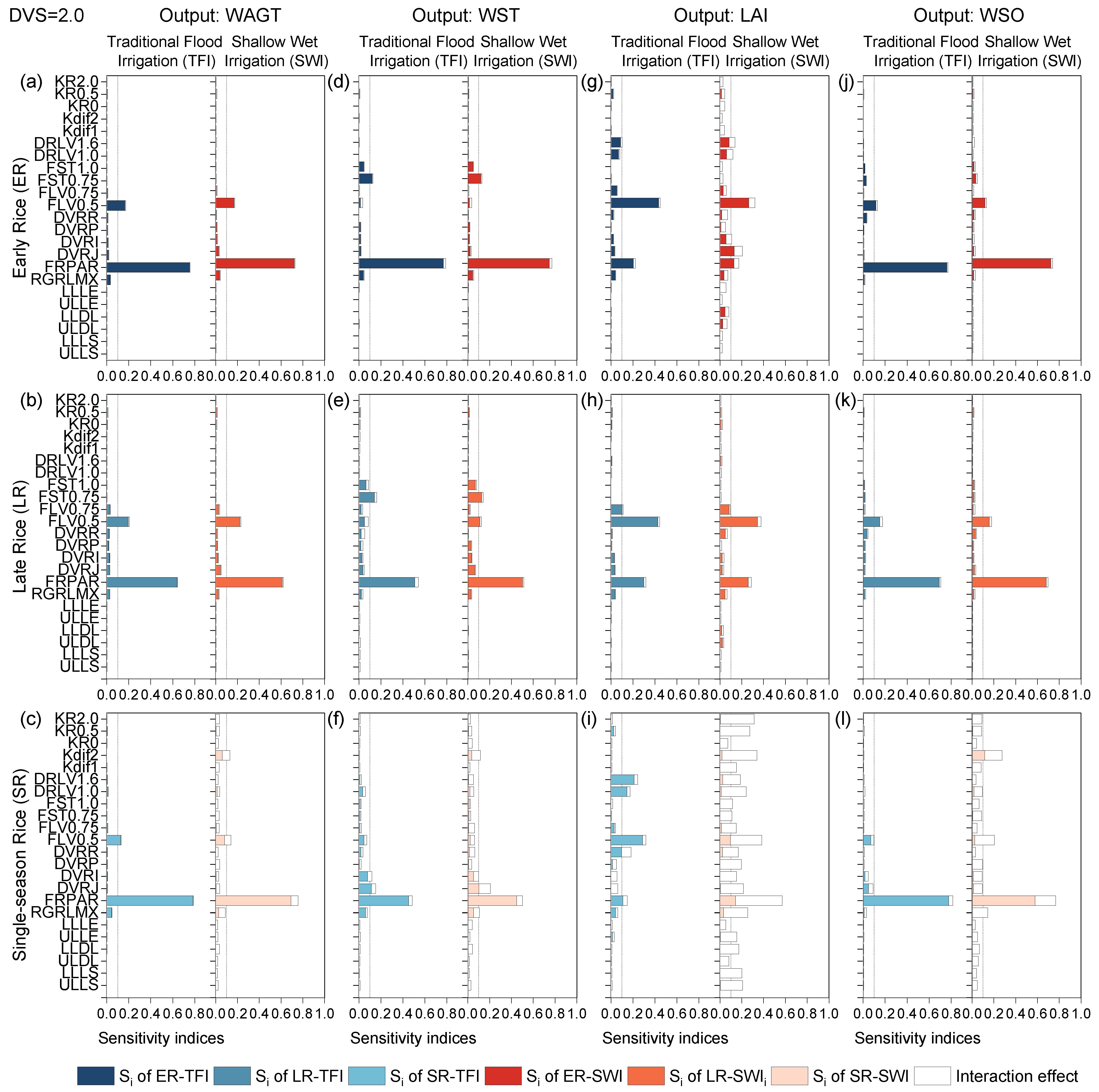

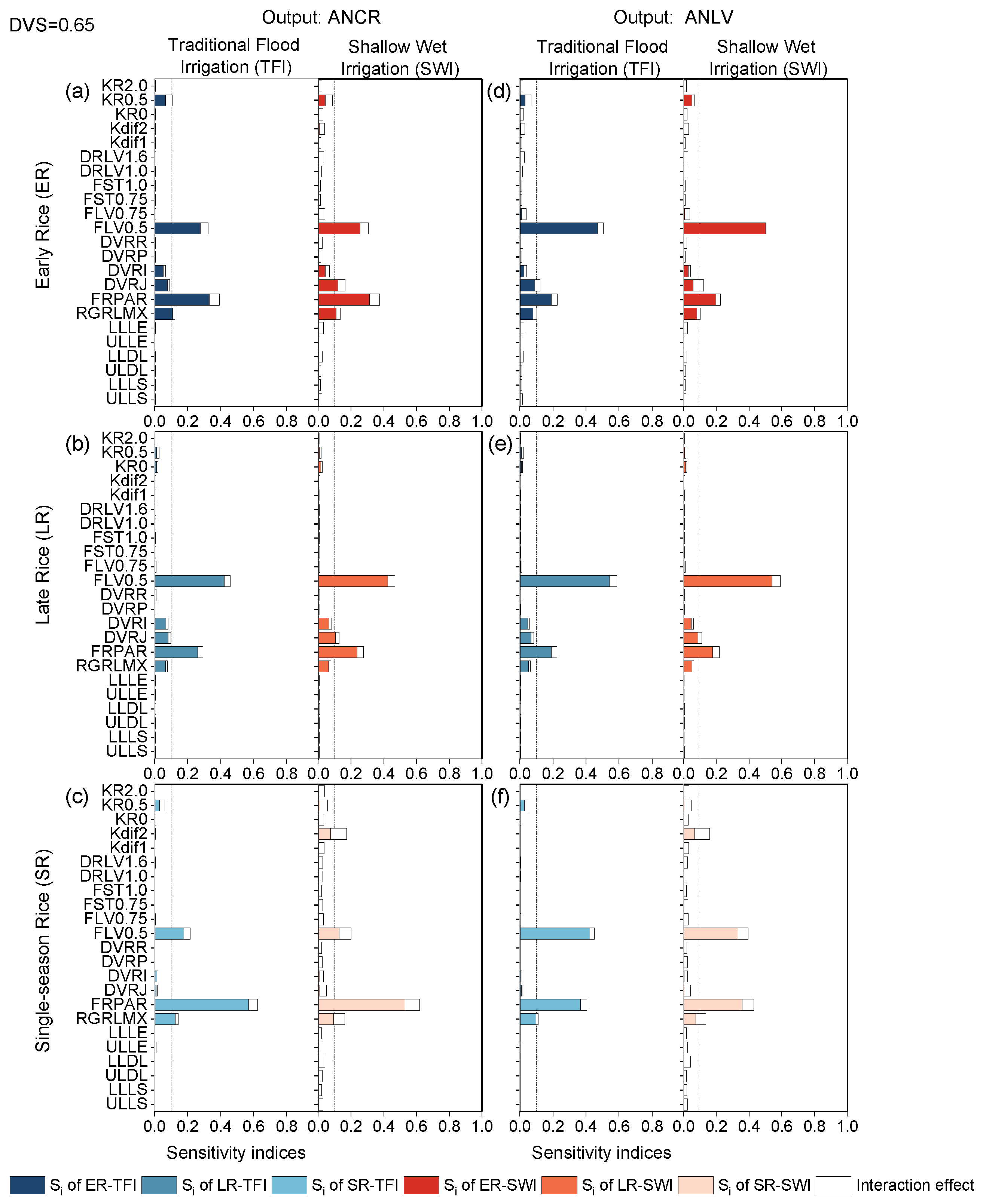

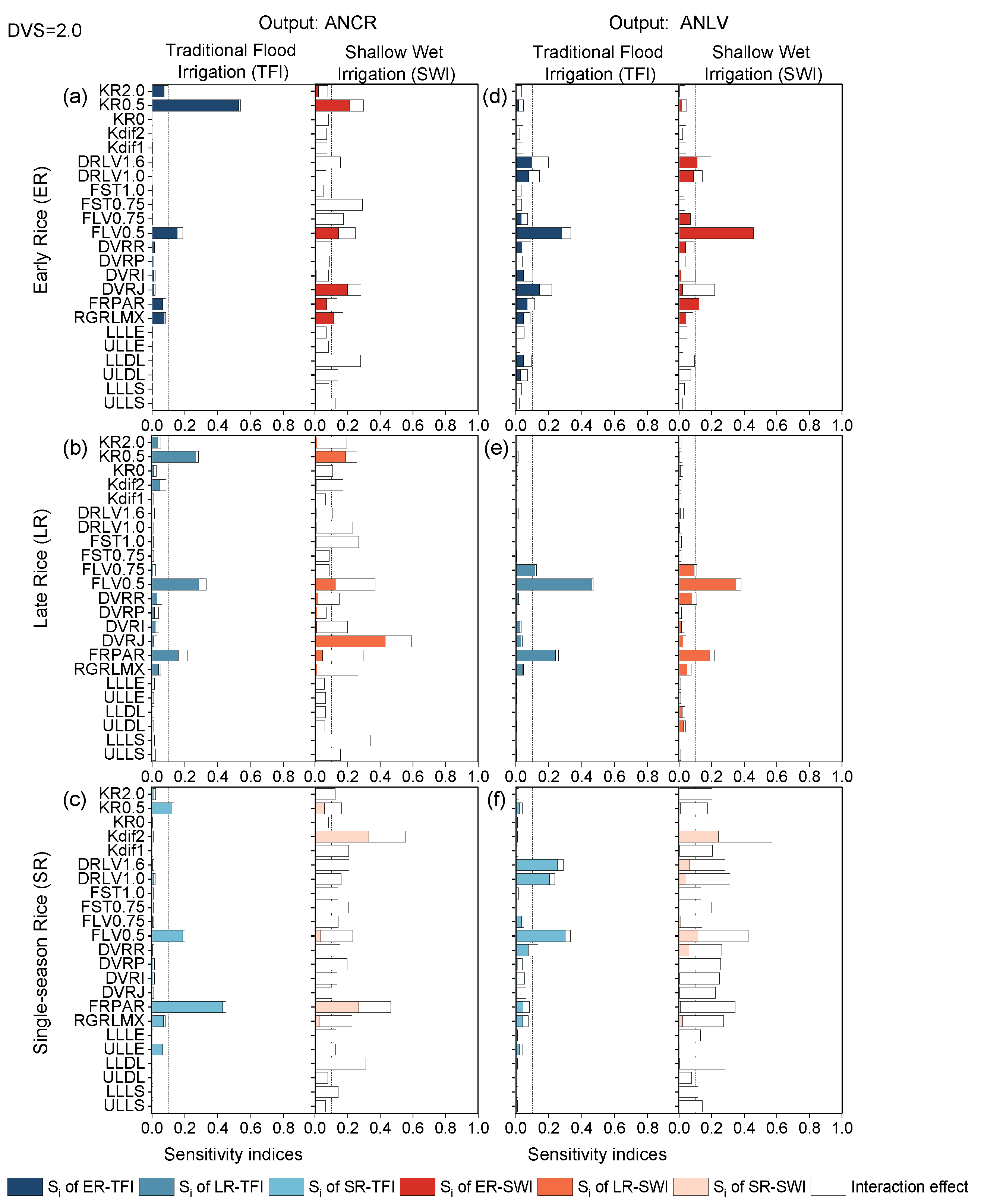
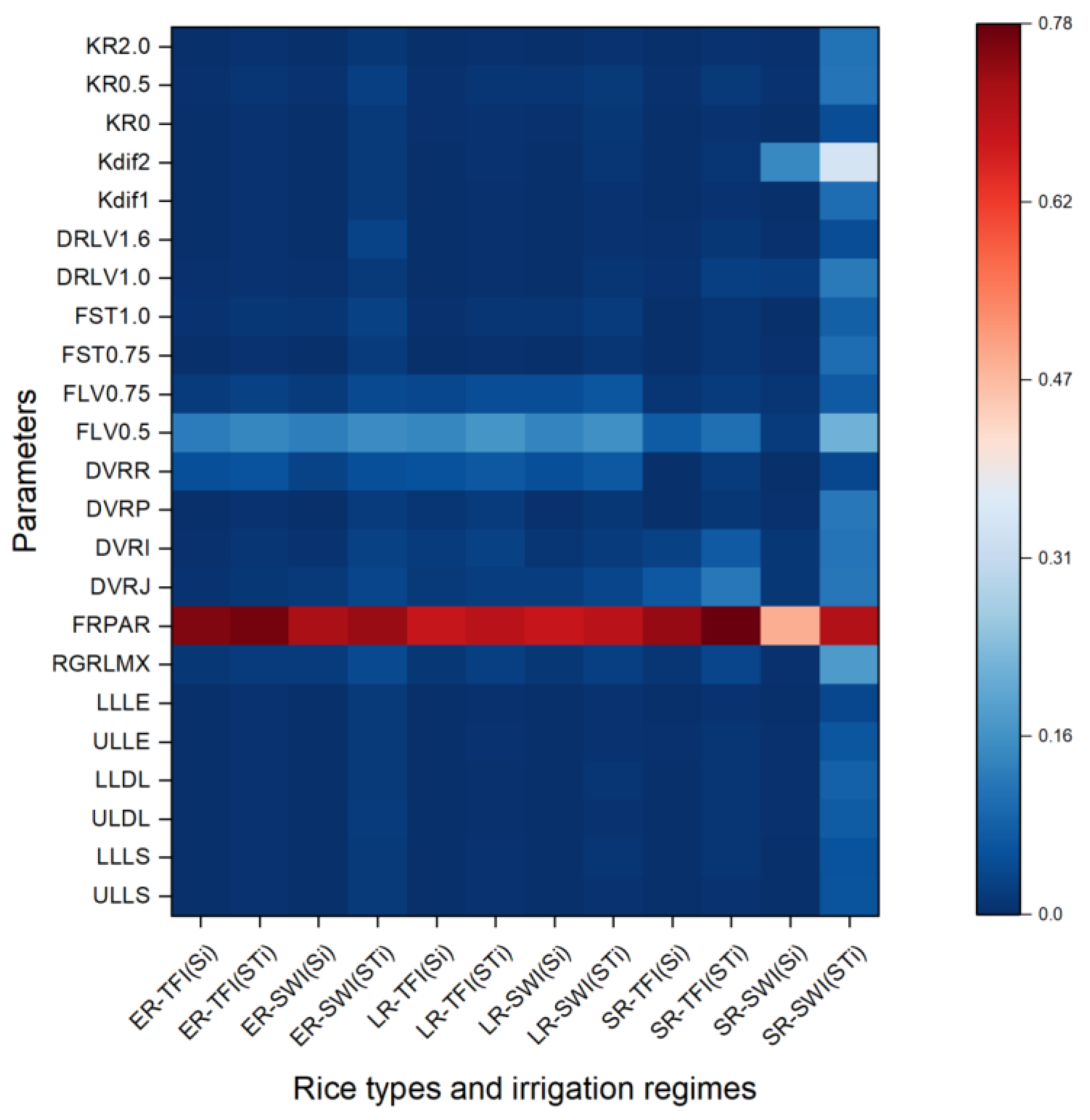
| Soil Horizon (cm) | Soil Particle-Size Distribution (%) | Bulk Density (g cm−3) | Soil Organic Matter (%) | ||
|---|---|---|---|---|---|
| Sand (2.0–0.05 mm) | Silt (0.05–0.002 mm) | Clay (<0.002 mm) | |||
| Single-season rice in Heilongjiang province, China | |||||
| 0–10 | 20.0 | 67.2 | 12.8 | 1.47 | 2.3 |
| 10–25 | 9.1 | 76. 9 | 14.0 | 1.48 | 3.3 |
| 25–40 | 11.3 | 74.9 | 13.8 | 1.53 | 2.5 |
| 40–80 | 17.8 | 71.7 | 10.5 | 1.29 | 4.0 |
| Double-season rice in Jiangxi province, China | |||||
| 0–20 | 8.1 | 70.0 | 21.9 | 1.343 | 2.1 |
| 20–50 | 11.3 | 67.2 | 21.5 | 1.617 | 1.4 |
| 50–100 | 6.4 | 71.2 | 23.4 | 1.675 | 0.9 |
| Phenology | Sowing | Transplanting | Panicle Initiation | Flowering | Maturity |
|---|---|---|---|---|---|
| Dates for single-season rice | 15 April 2019 | 16 May 2019 | 10 July 2019 | 2 August 2019 | 21 September 2019 |
| Dates for early rice | 22 March 2012 | 21 April 2012 | 23 May 2012 | 14 June 2012 | 10 July 2012 |
| Dates for late rice | 21 June 2012 | 19 July 2012 | 22 August 2012 | 14 September 2012 | 19 October 2012 |
| Treatment | Single-Season Rice (2019) | Early Rice (2012) | Late Rice (2012) | |||
|---|---|---|---|---|---|---|
| Date (Month–Day) | Net Nitrogen Amount (kg N ha−1) | Date (Month–Day) | Net Nitrogen Amount (kg N ha−1) | Date (Month–Day) | Net Nitrogen Amount (kg N ha−1) | |
| Base fertilizer | April 27 | 57.6 | April 19 | 90 | July 17 | 90 |
| Tillering fertilizer | May 29 | 33.5 | April 27 | 54 | July 29 | 54 |
| Panicle fertilizer | June 15 | 46.4 | May 26 | 36 | August 22 | 36 |
| Total | 137.5 | 180 | 180 | |||
| Parameters | Definition | Unit | Default Values for Single-Season Rice (Variation Ranges) | Default Values for Early Rice (Variation Ranges) | Default Values for Late Rice (Variation Ranges) |
|---|---|---|---|---|---|
| ULLS | Upper limit of leaf rolling | kPa | 74.13 (±30%) | 74.13 (±30%) | 74.13 (±30%) |
| LLLS | Lower limit of leaf rolling | kPa | 794.33 (±30%) | 794.33 (±30%) | 794.33 (±30%) |
| ULDL | Upper limit of drought-induced dead leaves | kPa | 630.95 (±30%) | 630.95 (±30%) | 630.95 (±30%) |
| LLDL | Lower limit of drought-induced dead leaves | kPa | 1584.89 (±30%) | 1584.89 (±30%) | 1584.89 (±30%) |
| ULLE | Upper limit of leaf expansion | kPa | 1.45 (±30%) | 1.45 (±30%) | 1.45 (±30%) |
| LLLE | Lower limit of leaf expansion | kPa | 1404 (±30%) | 1404 (±30%) | 1404 (±30%) |
| RGRLMX | Maximum relative growth rate of leaf area | (°Cd)−1 | 0.0088 (±30%) | 0.00877 (±30%) | 0.00904 (±30%) |
| FRPAR | Fraction of photosynthetically active sunlight energy | - | 0.45 (±30%) | 0.5 (±30%) | 0.62 (±30%) |
| DVRJ | Development rate during the juvenile phase | (°Cd)−1 | 0.000890 (±10%) | 0.000995 (±10%) | 0.001081 (±10%) |
| DVRI | Development rate during the photoperiod-sensitive phase | (°Cd)−1 | 0.000758 (±10%) | 0.000758 (±10%) | 0.000758 (±10%) |
| DVRP | Development rate during the panicle phase | (°Cd)−1 | 0.001055 (±10%) | 0.000981 (±10%) | 0.000853 (±10%) |
| DVRR | Development rate in reproductive phase (post-anthesis) | (°Cd)−1 | 0.002000 (±10%) | 0.002139 (±10%) | 0.001728 (±10%) |
| FLV0.5 | Fraction of shoot dry matter partitioned to the leaves at DVS = 0.5 | - | 0.5 (±30%) | 0.6 (±30%) | 0.6 (±30%) |
| FLV0.75 | Fraction of shoot dry matter partitioned to the leaves at DVS = 0.75 | - | 0.3 (±30%) | 0.3 (±30%) | 0.3 (±30%) |
| FST0.75 | Fraction of shoot dry matter partitioned to the stems at DVS = 0.75 | - | 0.3 (±30%) | 0.7 (±30%) | 0.7 (±30%) |
| FST1.0 | Fraction of shoot dry matter partitioned to the stems at DVS = 1.0 | - | 0.6 (±30%) | 0.4 (±30%) | 0.4 (±30%) |
| DRLV1.0 | Fraction of leaf death coefficient at the DVS = 1.0 | - | 0.024 (±30%) | 0.015 (±30%) | 0.003 (±30%) |
| DRLV1.6 | Fraction of leaf death coefficient at the DVS = 1.6 | - | 0.020 (±30%) | 0.025 (±30%) | 0.005 (±30%) |
| Kdif1 | Solute diffusion coefficient of the first soil layer, which is related to solute type and conduction method | mm2 d−1 | 100 (±30%) | 100 (±30%) | 100 (±30%) |
| Kdif2 | Solute diffusion coefficient of the next 9 soil layer | mm2 d−1 | 600 (±30%) | 600 (±30%) | 600 (±30%) |
| KR0.0 | Relative uptake of solutes by roots from soil at DVS = 0.0 | - | 5 (±30%) | 5 (±30%) | 5 (±30%) |
| KR0.5 | Relative uptake of solutes by roots from soil at DVS = 0.5 | - | 3 (±30%) | 3 (±30%) | 3 (±30%) |
| KR2.0 | Relative uptake of solutes by roots from soil at DVS = 2.0 | - | 3 (±30%) | 3 (±30%) | 3 (±30%) |
| Irrigation Regimes | Seeding | Early Tillering | Middle Tillering | Later Tillering | Jointing and Booting | Blooming | Grouting | Yellow Ripe |
|---|---|---|---|---|---|---|---|---|
| Lower Limit Criterion—Upper Limit Criterion | ||||||||
| Traditional flood irrigation (TFI) | 30 mm– 50 mm | 30 mm– 50 mm | 30 mm– 50 mm | Drainage | 30 mm– 50 mm | 30 mm– 50 mm | 30 mm– 50 mm | Naturally drying |
| Shallow–wet irrigation (SWI) | 10 mm– 30 mm | 80%θs– 15 mm | 80%θs– 15 mm | Drainage | 10 mm– 30 mm | 10 mm– 30 mm | 80%θs– 15 mm | Naturally drying |
Disclaimer/Publisher’s Note: The statements, opinions and data contained in all publications are solely those of the individual author(s) and contributor(s) and not of MDPI and/or the editor(s). MDPI and/or the editor(s) disclaim responsibility for any injury to people or property resulting from any ideas, methods, instructions or products referred to in the content. |
© 2024 by the authors. Licensee MDPI, Basel, Switzerland. This article is an open access article distributed under the terms and conditions of the Creative Commons Attribution (CC BY) license (https://creativecommons.org/licenses/by/4.0/).
Share and Cite
Gao, Y.; Sun, C.; Ramos, T.B.; Tan, J.; Oliveira, A.R.; Huang, Q.; Huang, G.; Xu, X. Global Sensitivity Analysis of the Advanced ORYZA-N Model with Different Rice Types and Irrigation Regimes. Plants 2024, 13, 262. https://doi.org/10.3390/plants13020262
Gao Y, Sun C, Ramos TB, Tan J, Oliveira AR, Huang Q, Huang G, Xu X. Global Sensitivity Analysis of the Advanced ORYZA-N Model with Different Rice Types and Irrigation Regimes. Plants. 2024; 13(2):262. https://doi.org/10.3390/plants13020262
Chicago/Turabian StyleGao, Ya, Chen Sun, Tiago B. Ramos, Junwei Tan, Ana R. Oliveira, Quanzhong Huang, Guanhua Huang, and Xu Xu. 2024. "Global Sensitivity Analysis of the Advanced ORYZA-N Model with Different Rice Types and Irrigation Regimes" Plants 13, no. 2: 262. https://doi.org/10.3390/plants13020262
APA StyleGao, Y., Sun, C., Ramos, T. B., Tan, J., Oliveira, A. R., Huang, Q., Huang, G., & Xu, X. (2024). Global Sensitivity Analysis of the Advanced ORYZA-N Model with Different Rice Types and Irrigation Regimes. Plants, 13(2), 262. https://doi.org/10.3390/plants13020262







